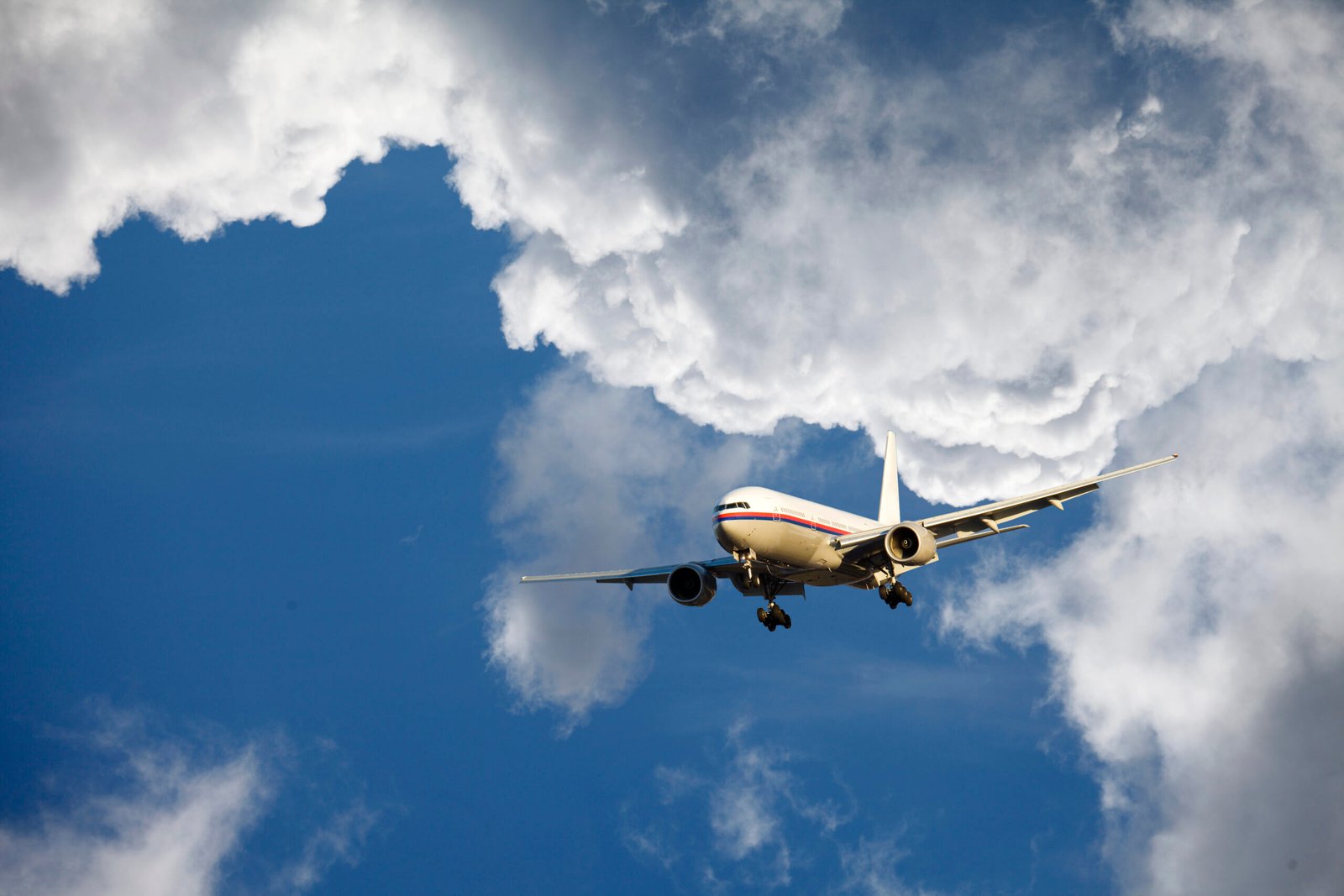aircraft
Flight Patterns: The Fascinating Evolution of Air Travel Through the Decades
Aviation, an industry that has revolutionized the way we traverse our planet, has undergone a remarkable transformation over the decades. From its humble beginnings in the early 20th century to today’s advanced technologies and training programs, air travel continues to evolve. One aspect that stands out in this evolution is the education and training of aspiring aviators. With various aviation schools offering specialized courses, enthusiasts can now navigate their way into a sky-high career.

When it comes to aviation education, there are several types of courses available tailored to different interests and career paths. For those aiming to become pilots, flight training schools provide comprehensive programs ranging from Private Pilot Licenses (PPL) to Airline Transport Pilot Licenses (ATPL). These courses cover everything from basic aerodynamics and meteorology to complex navigation techniques. Additionally, aspiring mechanics can enroll in Aircraft Maintenance Engineering programs that delve into aircraft systems, repairs, and regulatory compliance.
For individuals interested in air traffic control or aviation management, specialized courses are offered at various institutions. Air Traffic Control programs focus on communication protocols and safety regulations essential for maintaining order in busy airspaces. Similarly, Aviation Management degrees encompass business principles applied specifically within the aviation sector—preparing students for roles in airport operations or airline management.
Beyond formal education, numerous resources exist online for those seeking knowledge about aviation trends and news. Blogs like “The Points Guy” offer tips on maximizing travel rewards while providing insights into airlines’ latest offerings. Websites such as FlightAware allow users to track real-time flights globally—a fascinating tool for both enthusiasts and professionals alike.

Social media platforms have also become invaluable for aviation aficionados. Instagram accounts like @aviationdaily showcase stunning imagery from around the world—capturing breathtaking views of airplanes in flight or ground handling operations. Twitter hashtags such as #AvGeek unite individuals who share a passion for all things airborne; it’s a community where one can exchange experiences or learn about upcoming events.
In addition to traditional flight schools, FAA-approved flight training centers have gained prominence across the nation. These certified facilities adhere strictly to Federal Aviation Administration regulations while providing top-notch training using state-of-the-art simulators alongside actual flight experiences. Simulators play an integral role in modern pilot education by allowing students to practice emergency scenarios without jeopardizing safety. This innovative approach enhances skill development while building confidence before stepping into an actual cockpit.
Moreover, many FAA-approved flight schools offer programs designed for every level—from beginners taking their first lessons to seasoned pilots looking to upgrade their certifications or ratings. Each program is crafted with rigorous standards ensuring graduates are well-prepared for their careers ahead.
As we look back through decades of progress within air travel—from wooden biplanes soaring above fields to sleek jets cruising at high altitudes—it’s evident that ongoing education remains crucial for anyone wishing to soar in this dynamic field. Whether you’re passionate about piloting planes or fascinated by managing airport operations, today’s diverse array of aviation courses equips learners with necessary skills while connecting them with vibrant communities eager to share insights along their journey through the skies.
Embrace your inner aviator; explore these educational avenues and resources as you chart your own course through the thrilling world of aviation!
From Runway to Cloud: The Journey of an Airline Pilot
Becoming an airline pilot is a dream that dances in the minds of many aviation enthusiasts. But the journey from runway to cloud is paved with rigorous training, education, and passion. Let’s explore the diverse educational paths available for aspiring pilots, valuable online resources, and the critical role of FAA-approved flight schools.
*Aviation Schools by Types of Courses**
When it comes to pursuing a career in aviation, the choices can be overwhelming. Aviation schools offer various courses catering to different aspirations within the field:
1. **Private Pilot License (PPL) Programs:** These courses introduce students to fundamental flight principles, including navigation and aircraft operations. Ideal for those who want to fly recreationally or gain foundational skills.
2. **Commercial Pilot License (CPL) Courses:** For those aiming to make flying their profession, CPL programs dive deeper into advanced flying techniques, regulations, and flight planning.
3. **Airline Transport Pilot (ATP) Certification:** This is often regarded as the pinnacle of pilot certifications. ATP courses prepare candidates for positions with airlines and cover extensive knowledge on multi-engine operations and complex aircraft systems.
4. **Flight Instructor Ratings:** Many pilots choose to become Certified Flight Instructors (CFI) after obtaining their CPL or ATP credentials. This path allows them not only to gain hours but also share their passion for flying with future aviators.
5. **Specialized Training Programs:** These include courses on specific aircraft types or advanced maneuvers such as aerobatics or bush flying—perfect for those looking to specialize further.
*A List of Aviation Blogs, Websites, and Social Media Sites**
In this digital age, staying informed about trends in aviation is easier than ever! Here are some must-follow blogs and websites:
**Airline Reporter:** This blog covers airline news with a focus on technology and travel experiences.
**AvWeb:** A comprehensive source for aviation news that includes articles on safety issues and industry updates.
**Flying Magazine:** A well-respected publication that offers insights into pilot training, aircraft reviews, and real-life flying stories.
For social media enthusiasts:
**Instagram (@aviationdaily):** Follow stunning aerial photography showcasing breathtaking views from above.
**Twitter (@airlinepilotlife):** Tweets from airline pilots sharing day-to-day experiences in the cockpit.
**YouTube Channels like “Captain Joe” provide educational content alongside entertaining vlogs about life as a pilot.
*FAA Flight Schools/Airplane Schools/Simulators**
Navigating through your choices requires attention when selecting an FAA-approved flight school. These institutions adhere strictly to federal regulations ensuring high training standards:
**Part 61 vs Part 141 Schools:** Part 61 schools offer more flexible schedules tailored for working individuals while Part 141 schools provide structured curriculums ideal for full-time students aiming at quicker completion times.
**Simulator Training Facilities:** With advancements in technology, many flight schools incorporate advanced flight simulators into their curricula. Simulators allow students to practice emergency procedures safely without leaving the ground—an invaluable part of modern pilot training.
As you embark on this fascinating journey toward becoming an airline pilot—from mastering theoretical knowledge at a classroom desk to soaring through clouds—it’s essential to immerse yourself fully in both educational resources and community connections within aviation circles. Each step taken builds towards that exhilarating moment when you take control of an aircraft destined for horizons unknown!

A Journey Through the Skies: The Most Iconic Aircraft of All Time
Aviation, an enthralling blend of technology and artistry, has captured human imagination for over a century. From the Wright brothers’ first powered flight to modern jets that carve through the sky, aircraft have transformed how we traverse our planet. But to truly appreciate these iconic machines, one must first understand the foundation they stand upon—the education and resources available for aspiring aviators.
### Aviation Schools: Types of Courses
Before embarking on a journey through the skies, future pilots often seek knowledge at aviation schools. These institutions offer a broad array of courses designed to cater to various career paths within aviation.
*1. Private Pilot License (PPL)**
This is where many begin their flying journey. The PPL course covers essential flight training along with ground school topics such as navigation, regulations, and meteorology.
*2. Commercial Pilot License (CPL)**
For those looking to turn their passion into a profession, CPL programs delve deeper into advanced flight maneuvers and complex airspace management.
*3. Airline Transport Pilot License (ATPL)**
The pinnacle of pilot certification, ATPL prepares individuals for commanding commercial airliners, involving rigorous training on multi-engine aircraft.
*4. Flight Instructor Certification**
Many choose to become Certified Flight Instructors (CFI), allowing them not only to fly but also impart their knowledge onto others—creating a new generation of aviators.
In addition to these licenses, specialized courses in aeronautical engineering, aviation management, and air traffic control are also widely available across various institutions.
### Engaging with Aviation Online: Blogs and Social Media
With the digital age in full swing, numerous online platforms exist that cater to both seasoned pilots and aviation enthusiasts alike. Here’s a collection of valuable blogs and websites:

**Airliners.net:** An extensive database featuring photographs and discussions centered around various aircraft.
**Flying Magazine:** A publication dedicated to all things flying—from gear reviews to personal stories from pilots.
**The Points Guy:** While primarily focused on travel points and rewards, this site offers incredible insights into airline operations.
**Aviation Week:** Stay updated on industry news with articles covering everything from technology advancements to regulatory changes.
Social media provides another engaging avenue for those passionate about aviation:
**Instagram Accounts like @aviationdaily** showcase breathtaking aerial shots.
**YouTube Channels like ‘FlightChops’** give viewers immersive flight experiences through entertaining vlogs.
**Reddit’s r/flying community** allows for discussion among both novice aviators and experienced pilots alike.
### FAA Flight Schools: Simulators & Training
In the United States, FAA-approved flight schools are recognized as gold standards in pilot training. These establishments adhere strictly to safety regulations while providing top-notch instruction using state-of-the-art simulators alongside real aircraft training.
Simulators offer invaluable experience without leaving the ground—students can practice emergency landings or adverse weather conditions safely before taking their skills aloft. With increasingly sophisticated technologies mimicking real-life scenarios down to minute details such as instrument readings and environmental factors, students can hone their abilities effectively before reaching for the clouds.
Whether pursuing a recreational license or aiming high in an airline captaincy role, understanding these educational pathways enriches any aviator’s journey. As you prepare for takeoff into your own aviation adventure or simply appreciate some legendary planes soaring above—take heart; each iconic aircraft represents not just metal and machines but dreams realized against the backdrop of endless skies!


